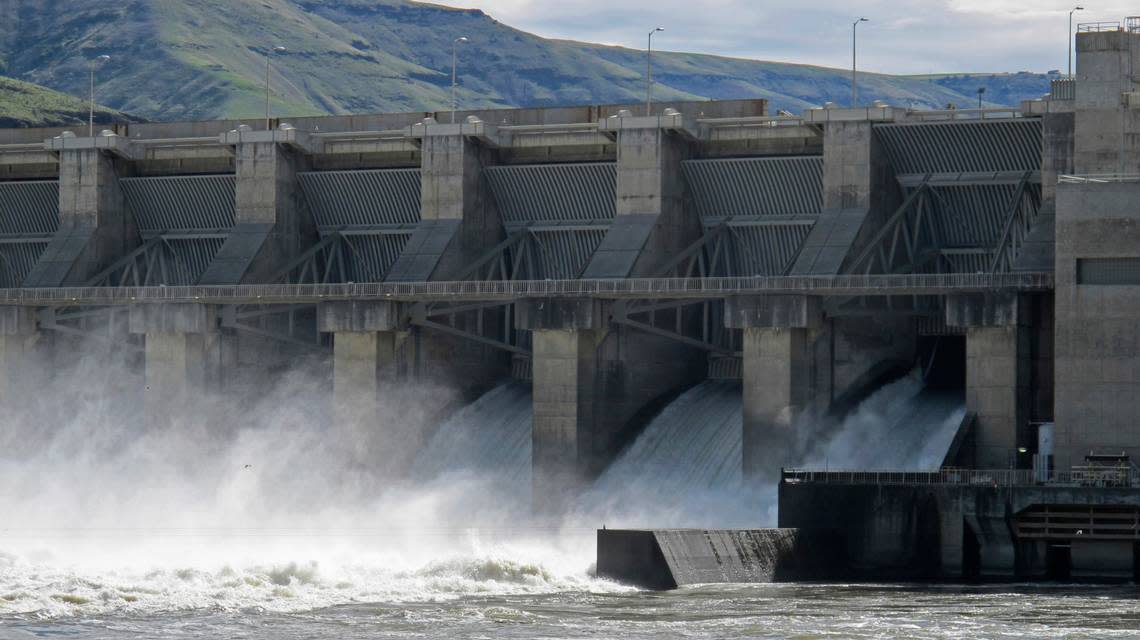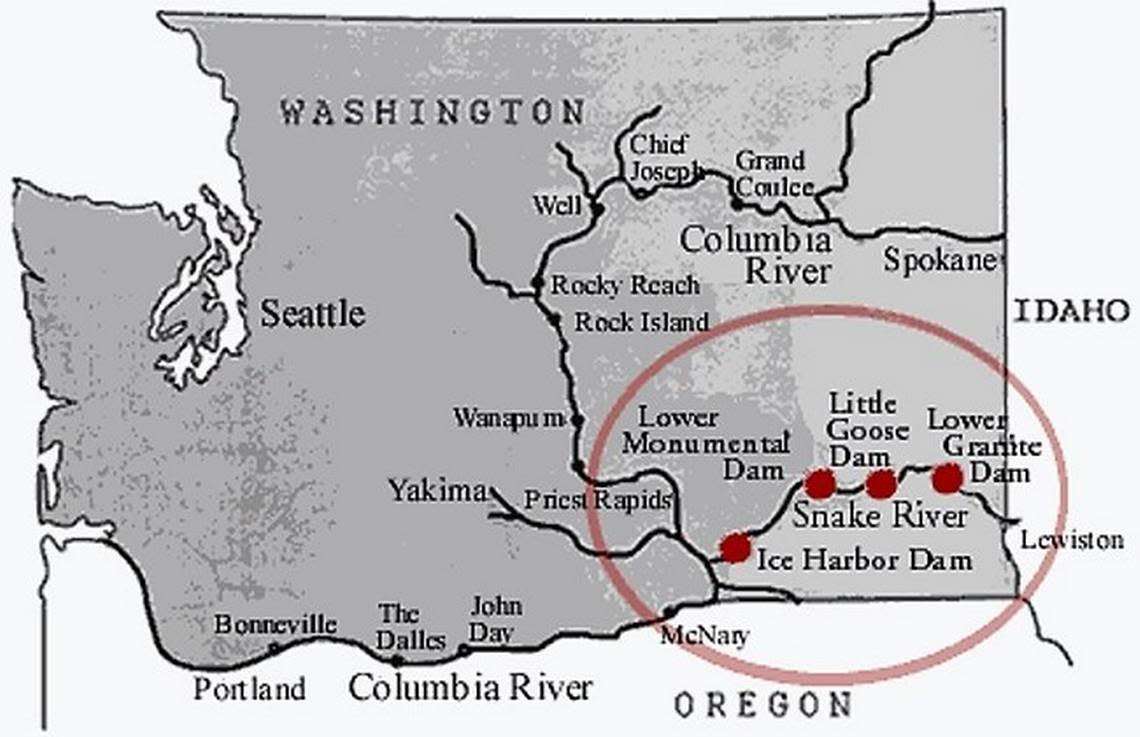‘Difficult and costly.’ Snake dams should be breached, says Biden administration report
Breaching one or more of the lower Snake River dams in Eastern Washington is called for in a National Oceanic and Atmospheric Administration draft report released Tuesday.
The draft report looks at the state of the science on restoring salmon and steelhead populations in the Columbia River Basin and the large scale actions needed to make progress toward healthy and harvestable fish stocks.
“It has become overwhelmingly clear that business as usual will not restore the health and abundance of Pacific Northwest salmon,” said Brenda Mallory, chairwoman of the White House Council on Environmental Quality, at a news media briefing Monday afternoon.
“We need a durable, inclusive and regionally crafted long-term strategy for the management of the Columbia River Basin,” she said.
The NOAA draft report recommends breaching one or more of the Snake River hydroelectric dams, reintroducing fish to areas of the Columbia River Basin where other dams now block spawning habitat and improving fish passage at dams in the lower Columbia River, said Janet Coit, assistant administrator for NOAA Fisheries.
“We know this will be difficult and costly,” she said.

But this is a crucial moment for the future of salmon and and steelhead populations in the Columbia River Basin as climate change is adding to other stressors on the fish, she said.
The NOAA draft report, “Rebuilding Interior Columbia Basin Salmon and Steelhead,” said the science calls for “acting, and acting now.”
“Inaction will result in the catastrophic loss of the majority of Columbia River Basin salmon and steelhead stocks,” the draft report said.
Going big and breaching dams
Salmon life-cycle models predict that breaching the lower Snake River dams, plus more water spilled over the lower Columbia River dams and freshwater habitat restoration, would likely achieve regional survival and productivity targets for Snake River chinook salmon and steelhead, the draft report said.
The four dams targeted for possible breaching are those from Ice Harbor Dam near the Tri-Cities upriver to Lower Granite Dam near Lewiston, Idaho.
Chris Jordan, one off the scientists who worked on NOAA’s draft report, said extensive actions have been taken in the last 20 years — in the hydroelectric system, the estuary, hatchery programs and predatory management — without seeing hoped for salmon recovery.
“We argue in thinking about the science in this current report that we need to go to larger scale actions and more cohesive systematic planning,” he said.

The Biden administration has not endorsed or recommended the actions in the draft report, including breaching dams, Mallory emphasized.
But the draft report and a second report released Tuesday on the costs of replacing power from the lower Snake River dams will inform decisions on how to restore salmon populations and honor treaties with Columbia River tribes, she said.
“Developing this kind of information is critically important to being able to honestly assess the opportunities, the challenges and the costs of restoring the health and abundance of salmon in the Columbia River Basin,” she said.
The draft report also looks at management of predators, restoration of tributary and estuary habitat, and hatchery and fish harvest reforms.
The long-term outlook now for some fish stocks does offer “a bit of hope,” as their numbers increase when environmental conditions are favorable and as improvements are made in their environments, the NOAA draft report said.
“However, all optimism about potential future stock status must be tempered by the continued pressure from a changing climate and the ever-expanding human footprint,” the draft report said.
“Only rapid, concerted, system-wide actions keyed to existing strongholds of stock potential will result in durable biological benefit to interior Columbia stocks,” it said.
Benefits to breaching Snake dams
Breaching Snake River dams could decrease travel time for juvenile fish headed toward the ocean, reduce their death and injury in powerhouses, and reduce stress associated with their hydrosystem experience that results in delayed deaths before they reach the ocean, the draft report said.
The U.S. Fish and Wildlife Service provided input on the draft report along with scientists and fishery managers from the Nez Perce Tribe and the state of Oregon.

The actions recommended in the draft report would benefit other species in addition to salmon, including bull trout and lamprey, said Martha Williams, director for U.S. Fish and Wildlife.
Now fish ladders at dams prevent passage of about 50% of adult Pacific lamprey, such that fewer than 1% make it to the upper portions of the Columbia and Snake river basin, the draft report said. And juvenile lamprey die en masse when they hit the turbine screens meant to protect juvenile salmon, it said.
The northern pikeminnow that feed on juvenile salmon and steelhead could be reduced if the reservoirs behind dams that they thrive in were eliminated, the draft report said.
Similarly, faster flowing water could reduce undesirable species like walleye, smallmouth bass and catfish that feed on native juvenile salmon, steelhead and lamprey, it said.
Replacing Snake dams hydropower
The second report released Tuesday, “BPA Lower Snake River Dams Power Replacement Study,” was commissioned by the Bonneville Power Administration and prepared by Energy and Environmental Economics.
“Replacing the four lower Snake River dams while meeting clean energy goals and system reliability is possible, but comes at a substantial cost,” it concluded.
It estimated that the cost would be $11 billion to $19 billion to replace power production by 2045.

If public power customers had to pay that cost, they would be billed an estimated $100 to $230 more per household per year, the study found.
However, a Department of Energy official said it was “exceedingly unlikely” that Congress would allow the cost of replacing power systems to fall on BPA customers.
Hydropower could be replaced in five to seven years, but it is possible that the work could take 10 to 20 year if large new energy transmission systems are required, said Jeremiah Baumann, chief of staff for the DOE Office of Infrastructure, which oversees BPA.
The cost projection of up to $19 billion relied on what he called “realistic scenarios” of technology improvement.
The two new federal reports come a month after a draft report ordered by Gov. Jay Inslee and Washington U.S. Sen. Patty Murray, both democrats, found that breaching the dams was doable.
Murray and Inslee will use the final report to make a recommendation about the future of the dams.
